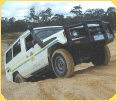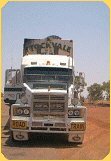 |
 |
|
|
|
||
|
Outback Info (Private Seiten) © seit 1999 Wolfe Creek Crater National Park
Although it has long been known to Aboriginal people, who called it Kandimalal, the Wolfe Creek meteorite crater was only discovered by Europeans in 1947, during an aerial survey. The Aboriginal Dreaming tells of two rainbow snakes who formed the nearby Sturt and Wolfe Creeks as they crossed the desert. The crater is believed to be the place where one snake emerged from the ground. This striking formation is now protected by a reserve. Wolfe Creek was named in 1889 after Robert Wolfe, a prospector and storekeeper of Halls Creek, who was chairman of the Kimberley Goldfields Roads Board. On the edge of the Great Sandy Desert and the extensive spinifex grasslands of the East Kimberley lies the Wolfe Creek meteorite crater, the second largest crater in the world from which fragments of a meteorite have been collected. The crater is 880 metres across and almost circular. Today, the floor is about 60 metres below the rim, and is generally flat, but rises slightly in the centre. The porous gypsum found in this central area supports reasonably large trees and contains a number of sinkholes that may reflect the position of stress fractures formed by the impact from the meteorite.
The crater is inhabited by a variety of wildlife. Among the broken rocks on the crater wall you may see a brown ringtail dragon stalking insects that frequent the flowering shrubs. These shrubs grow well along the crater rim, where moisture is contained beneath the rocks. Mammals are active at dawn and dusk, avoiding exposure during the heat of the day. Red kangaroos live in the area but are rarely seen. Although the dry desert conditions restrict the number of birds in the park, spectacular and noisy Major Mitchell cockatoos harvest seeds from the wattles and paperbarks of the crater floor. However, most visitors come to the park to marvel at the crater itself. Formation Scientists have made an intensive study of the Wolfe Creek meteorite crater. Dating of the crater rocks and the meteorite have shown that it crashed to Earth around 300,000 years ago - relatively recently, in geological terms. It would have weighed more than 50,000 tonnes and is thought to have been travelling at 15 kilometres a second, a speed which would have taken it across Australia in five minutes. The impact of its enormous mass would have punched a huge hole in the ground, pulverising the underlying rocks and putting a sudden halt to its progress.
Within seconds, the energy caused by its tremendous mass and velocity would have been converted to heat, melting and vaporising the meteorite and causing a massive explosion (like an exploding pressure cooker) that sent debris flying in every direction and deformed the surrounding rocks. This helps to explain why some fragments of iron meteorite have been found about four kilometres away. Rusty balls of rock, known as "shale-balls", lie on the top of the slopes of the crater, particularly on the western side. Some of these are scattered on the ground, but other chunks are fused into the laterite capping. They contain iron-nickel and iron-phosphide and are the deeply rusted remains of iron meteorites. Similar rocks are associated with other large craters around the world. The effects of the impact on the surrounding rocks can also be seen. The area in which the crater has formed is quartzite capped with laterite. The quartzite, which became distorted as a result of the explosive impact, is clearly visible on the inner walls. The laterite which once capped the quartzite can now be seen in some places, sandwiched between layers of folded quartzite. The crater which resulted was probably up to 120 metres deep but has been filled by blown sand and gypsum over the intervening hundreds of thousands of years.
Secrets from Space The Earth has been so altered since it was formed 4,600 million years ago that there is little or no evidence available to scientists that illustrate its earliest history, or which helps to shed light on how planets were made. Most meteorites, on the other hand, are believed to be among the earliest solid rocks to form in our Solar System, and have remained unchanged. The most common meteorites, the chondrites, are composed of numerous rounded grains, known as chondrules. Chondrules are thought to be among the first matter to solidify from the cloud of gas and dust that gave birth to the Sun and its planets. Their accumulation eventually led to the formation of larger bodies and, ultimately, to the planets of our Solar System. Meteorites are therefore regarded as precious relicts from outer space containing clues to the very beginning of our Solar System. Meteorites may even contain information as to how living organisms first evolved. Some meteorite fragments recovered from other parts of Australia have been shown to contain amino acids, which are the building blocks of life. Could it Happen Today? Scientists have also speculated about the chances of a large meteoroid plunging to Earth this century. Most fragments that enter our atmosphere burn out as meteors before they reach the surface of the planet, due to friction with atmospheric gases. Their progress may, however, produce quite a spectacular light show. Many others plunge harmlessly into the ocean, while some actually fall to land as relatively small fragments. Fragments from some 450 or so different meteorites have so far been recovered from Australia and more than 16,000 fragments have been excavated from the Antarctic ice, where they have been protected from the deep weathering processes they would have experienced elsewhere in the world. Many of the large craters from earliest times would also have been weathered away from the surface of our planet over the last few thousands of millions of years. It is estimated that meteorite impacts on the scale seen at Wolfe Creek may occur every 25,000 to 50,000 years. Collisions on a scale capable of causing a major catastrophe may take place only once every 15 million years. It is thought that more than 1,000 asteroids greater than a kilometre in diameter have orbits that cross that of Earth. So although there is only the most remote chance of such an event occurring during our lifetime, it is nevertheless a very real possibility. There is also mounting scientific evidence that one or more giant meteorites collided with Earth during the end of the Cretaceous period, and some scientists believe that such an event may have contributed to the extinction of the dinosaurs and other animals that died around that time. These theories may not be as far-fetched as they initially sound. At many places throughout the world, a thin layer of clay has been deposited in layers of rock aged at some 65 million years. These deposits contain the metallic element iridium, which is rare in the Earth's crust, but often present in meteorites. It is thought that such an occurrence would have triggered a global holocaust, blasting more than 10 000 cubic kilometres of dust into the atmosphere, obliterating the Sun and making it impossible for many plants and animals to survive. The evidence for impact is very strong, but whether it was responsible for mass extinctions is still disputed. Nobody really knows for sure, but the possibility is certainly intriguing. Or perhaps, like local Aboriginal people, you would prefer to believe that Wolfe Creek crater was created by a powerful rainbow serpent during the Dreamtime. Whatever you believe, there is no doubt that meteorites and the remarkable meteorite crater at Wolfe Creek will fascinate humankind for many years to come. THINGS YOU NEED TO KNOW
Where is it? Travelling time: What to do:
Facilities: Best season:
|
||
Schatzsuche in Down Under / Fossicking
|
||||||||||||||||||||||||||||||||||||||||||||||||||||||||||||||||||||||||||||||||||||||||||||||||||||||||||||||||||||||||||||||||||||||||||||||||||||||||||||||||||||||||||||||||||||||||||||||||||||||||||||||||||||||||||||||||||||||||||||||||||||||||||||||||||||||||||
Australien-Kanal.de © seit 1999, Fossicking.de © seit 1999






